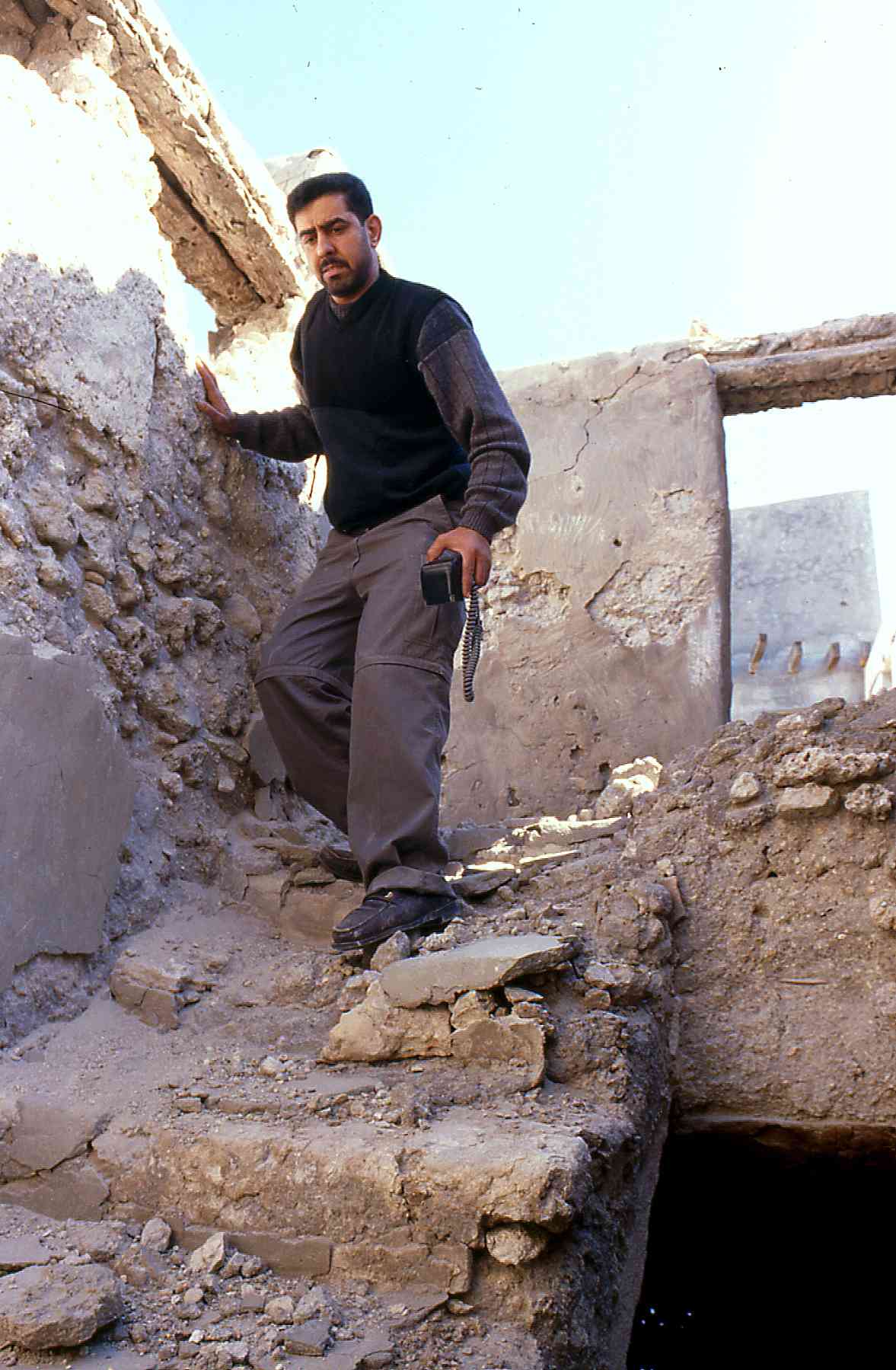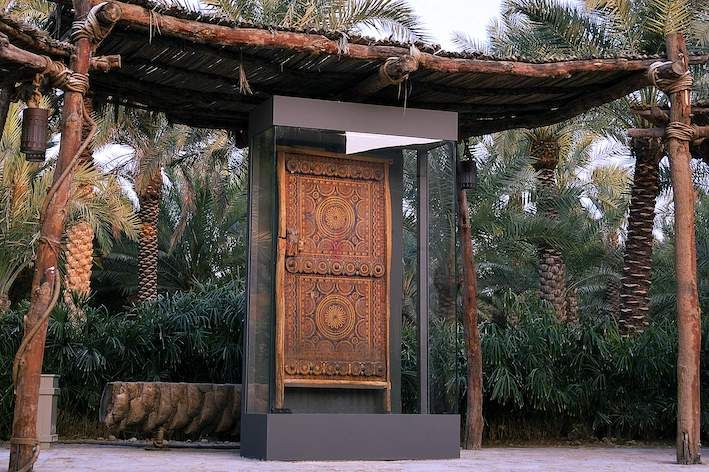Doors of Wooden Dreams
A carved mullion with traditional baythana ornamentation. Courtesy of Dr. Saeed.
Great ventures often start with contemplation, and in the beginning of his career Dr. Saeed Alwayel regularly pondered how much of man is bound to that which protects him from the hubbub of the world, provides shelter, and serves as an entryway to his safe personal space. Dr. Saeed set out to study doors closely in the eastern regions of the Arabian Peninsula, examining their designs, ornamentation and development over time, as well as the influence of the Islamic culture upon their profile, and that of other cultures that engaged in commerce with the region.
To learn about doors, the development of their craft on the east coast, their traditional designs and inherent meanings, and the relationship between functionality and aesthetics in traditional craftsmanship we interviewed Dr. Saeed who has become a great expert on the subject, publishing five books about doors, ornamentations and design elements, and is on the cusp of publishing two major works concerning doors and a dictionary of colloquial terms used by traditional craftsmen across Arabia.
He is an artist and painter who dedicated more than four decades of his life to document urban heritage and study the elements of traditional craftsmanship. He began by focusing on Al-Hasa and the eastern coast and collaborated with the Centre for Popular Heritage in Doha (1982 – 2005) to publish his articles and academic papers about urban craftsmanship.

Dr. Saeed Alwayel during the interview, 2024. Photo by Nuqta.

Renowned Qatifi door-maker Alawi Al-Sadah holding a jaddoom wood hammer. Courtesy of Dr. Saeed.
“I started by seeking out craftsmen, carpenters, smiths, and builders and sat down with them in their homes and workshops, and I was able to collect info that would not have been attainable otherwise. When I first began, there were other publications that showcased traditional crafts but only on the surface, mere catalogs with little or no commentary. Whereas, I wanted to hear their stories, learn about their struggles, the reasons behind their choices of tools and materials, and the hidden messages, symbolism if you will, behind the design elements.”
After collaborating with the Heritage Centre in Doha, Dr. Saeed traveled to Sharjah, where he got to work closely with Dr. Abdessatar Azzawi - who oversaw renovating traditional areas - which allowed Dr. Saeed to examine these areas while they were intact. This first-hand exposure proved instrumental in his career and inspired him to discover the great wealth that was ripe and ready to be plucked by the keen observer. He first examined the design elements of decorative plaster work, which prompted him to notice the similarity it had with some of the ornamentations applied on doors, and thereby question the relationship they had with one another, and whether this was an aesthetic choice or a necessity that held the crafted piece together.

Renowned Hasawi door-maker Dawood AlHassan practicing his craft of ornamentation. Photo by Dr. Saeed.

Dr. Saeed at a traditional site in his youth. Courtesy of Dr. Saeed
When asked about the development of door designs and their raw materials over time, and the effect that trade routes had on the craft of door-making, Dr. Saeed said:
“This is actually one of the subject areas that we were able to trace and document, and it is a factor that is more associated with the development of doors than other crafts such as decorative plaster work. Craftsmen started by using wood found in local trees such as palm trees, tamarisk and the sidr tree (also known as jujube).
“This can be traced to two time periods, the first of which is during the peak of the pearl trade in the Gulf, and the second period commenced upon the discovery of fossil fuel. Both periods have affected the craft tremendously and shaped its development, as the twilight of the first one saw craftsmen moving in from making ships to crafting doors and influencing their design elements and bringing on their seafaring language to the craft of door-making.”
“Both historic moments opened our area to the world, resulting in importing sturdier and lighter wood from India and Africa, so that craftsmen could manipulate it with more ease and create uniform designs, different design profiles.”
Double-door carved with fig tree leaf ornamentation in the Abu Jaro-mullion style from al-Hasa. Photo by Dr. Saeed.
A nested door commonly known as Abo Khokha belonging to the Sheikh of the Khuwalid tribe in Jubail. Courtesy of Dr. Saeed.
A traditional door in Qatif with carved Quranic inscriptions. Courtesy of Dr. Saeed.
Door makers were carpenters by profession, but it was considered the highest form of carpentry for it required tremendous skill and attention to detail. It was passed down across generations, and each family had their signature designs and special tools that made them stand out. When asked about what door makers thought of their tools, and how the development of manufacturing and shipping has affected the craft, Dr. Saeed said: “Smiths and carpenters were the best of friends, each one’s livelihood relied on the other, and each craftsman took great pride in their tools, for they were what made his work stand out and built his reputation in the market. What would seem at first glance to be a uniform design, was in fact not.
People had a feeling for good craftsmanship, and they sought after the best door makers, and those same door makers, who usually came from Al-Hasa or Qatif, moved around the east coast for work. They had their own tools, and their backgrounds meant that each had a different outlook for what a door should be as a final product. This is also true to the purpose this door would serve, and what kind of building it would be attached to.”
“Over time, when technology inevitably developed and globalization happened, door makers also shifted their focus, and the design profiles began to match those of the rest of the world for the entire design of homes and residential buildings had also experienced a tremendous change. But what I would like to highlight is that doors did not look the way they did for the sheer aesthetic or merely as beautifying elements; each attached item was necessary for the structural integrity of the crafted piece.”

Mullion carved in the Abu Khuwazrin-style from Farij Al-Shimali area in al-Hasa. Courtesy of Dr. Saeed.

Example of a mullion carved in the Muscati-style in al-Hasa. Courtesy of Dr. Saeed.
Example of a traditional mullion carved in the Abu Khuwazrin-style in al-Hasa. Courtesy of Dr. Saeed.
“When addressing door-making we are talking about a branch of crafted professions that had long existed in the Saudi society, especially in the Eastern Province and in Al-Hasa. But what has changed is the collected attitude toward art as an aesthetic expression as opposed to it serving a certain function without compromising the structure of the final product. It was not just something to look at and admire, it had a role and a function that it served with gusto.
“What mattered most was the making of functional doors, but craftsmen who had the talent and ability to make impeccable products enjoyed a bigger market share and their reputations went above and beyond their local community. They traveled to other regions and left their mark and influenced the design trends in those areas.
“In short, the craft of door-making and wood ornaments is a mixture of art and craftsmanship, but with a focus on functionality.”
After decades in the field of academic research and focusing on a marginalized area that did not enjoy the spotlight that others had, Dr. Saeed spoke about his own experience, highlighting the breakthroughs he has had and how it influenced his life: “My research had a tremendous impact on my art, but not only that. I got to learn a lot about the history of craftsmanship in our region, met with highly talented door makers and craftsmen, documented whatever I stumbled on, and got to make the Arabic library richer. It makes me proud that what I have dedicated my life to is going to benefit the new generations, and that the youth are asking the right questions, paying it attention, and showing it great interest.”
.
Nuqta Agency helped record this interview and took photographs of Dr. Saeed right after.


